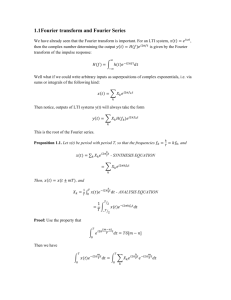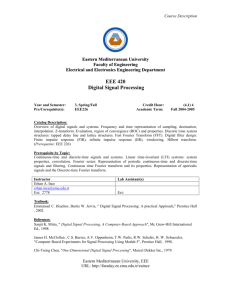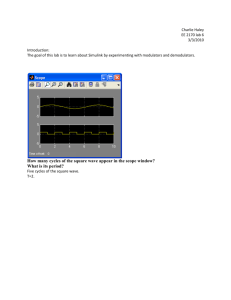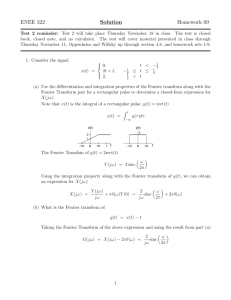Chapter 4 The Fourier Series and Fourier Transform +
advertisement
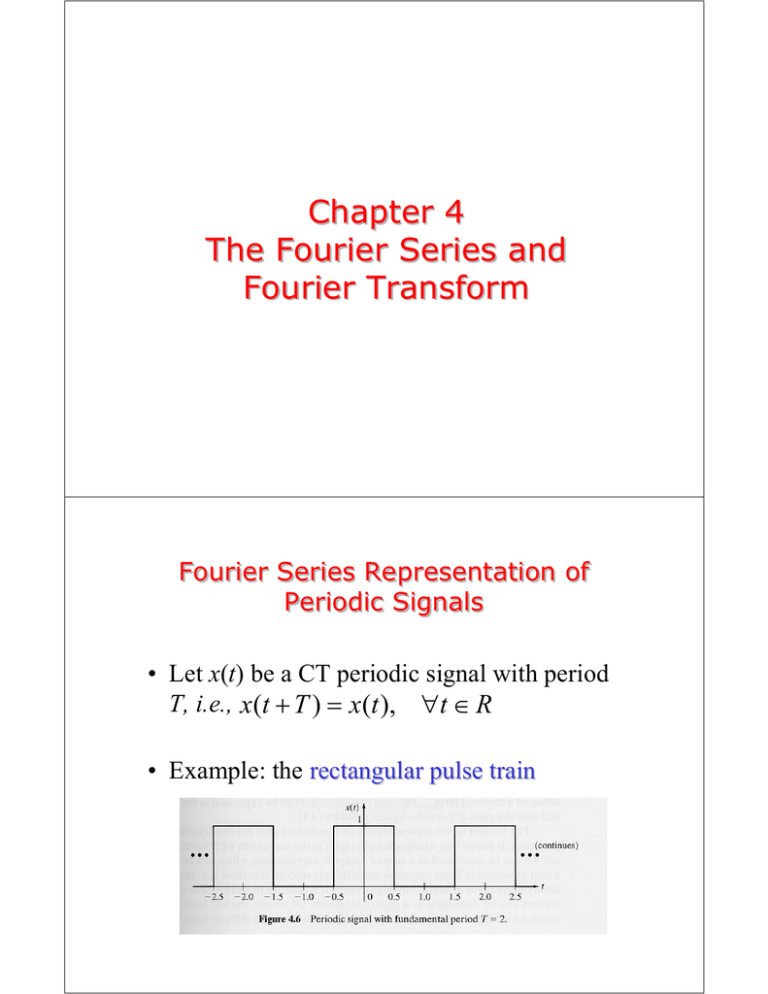
Chapter 4 The Fourier Series and Fourier Transform Fourier Series Representation of Periodic Signals • Let x(t) be a CT periodic signal with period T, i.e., x(t + T ) = x(t ), ∀t ∈ R • Example: the rectangular pulse train The Fourier Series • Then, x(t) can be expressed as x(t ) = ∞ ∑ce k =−∞ k jkω 0 t , t∈ where ω 0 = 2π / T is the fundamental frequency (rad/sec) of the signal and T /2 1 − jkω o t ( ) ck = x t e dt , k = 0, ±1, ±2,… ∫ T −T / 2 c0 is called the constant or dc component of x(t) Dirichlet Conditions • A periodic signal x(t), has a Fourier series if it satisfies the following conditions: 1. x(t) is absolutely integrable over any period, namely a +T ∫ | x(t ) | dt < ∞, ∀a ∈ a 2. x(t) has only a finite number of maxima and minima over any period 3. x(t) has only a finite number of discontinuities over any period Example: The Rectangular Pulse Train • From figure T = 2, so ω 0 = 2π / 2 = π • Clearly x(t) satisfies the Dirichlet conditions and thus has a Fourier series representation Example: The Rectangular Pulse Train – Cont’d ∞ 1 1 x(t ) = + ∑ (−1)|( k −1) / 2| e jkπ t , t ∈ 2 k =−∞ kπ k odd Trigonometric Fourier Series • By using Euler’s formula, we can rewrite x(t ) = ∞ ∑ k =−∞ as ck e jkω0t , t ∈ ∞ x(t ) = c0 + ∑ 2 | ck |cos(kω 0t + ∠ck ), t ∈ k =1 dc component k-th harmonic as long as x(t) is real • This expression is called the trigonometric Fourier series of x(t) Example: Trigonometric Fourier Series of the Rectangular Pulse Train • The expression ∞ 1 1 x(t ) = + ∑ (−1)|( k −1) / 2| e jkπ t , t ∈ 2 k =−∞ kπ k odd can be rewritten as 1 x(t ) = + 2 ∞ ∑ k =1 k odd 2 π⎞ ⎛ cos ⎜ kπ t + ⎣⎡(−1)( k −1) / 2 − 1⎦⎤ ⎟ , t ∈ kπ 2⎠ ⎝ Gibbs Phenomenon • Given an odd positive integer N, define the N-th partial sum of the previous series 1 xN (t ) = + 2 N ∑ k =1 2 π⎞ ⎛ cos ⎜ kπ t + ⎡⎣(−1)( k −1) / 2 − 1⎤⎦ ⎟ , t ∈ 2⎠ kπ ⎝ k odd • According to Fourier’s theorem, theorem it should be lim | xN (t ) − x(t ) |= 0 N →∞ Gibbs Phenomenon – Cont’d x3 (t ) x9 (t ) Gibbs Phenomenon – Cont’d x21 (t ) x45 (t ) overshoot: overshoot about 9 % of the signal magnitude (present even if N → ∞) Parseval’s Theorem • Let x(t) be a periodic signal with period T • The average power P of the signal is defined as T /2 P= 1 2 (t )dt x ∫ T −T / 2 ∞ • Expressing the signal as x(t ) = ∑ ck e jkω t , t ∈ k =−∞ it is also 0 P= ∞ ∑ |c k =−∞ k |2 Fourier Transform • We have seen that periodic signals can be represented with the Fourier series • Can aperiodic signals be analyzed in terms of frequency components? • Yes, and the Fourier transform provides the tool for this analysis • The major difference w.r.t. the line spectra of periodic signals is that the spectra of aperiodic signals are defined for all real values of the frequency variable ω not just for a discrete set of values Frequency Content of the Rectangular Pulse x(t ) xT (t ) x(t ) = lim xT (t ) T →∞ Frequency Content of the Rectangular Pulse – Cont’d • Since xT (t ) is periodic with period T, we can write xT (t ) = ∞ ∑ k =−∞ ck e jkω0t , t ∈ where T /2 1 − jkω o t ( ) ck = x t e dt , k = 0, ±1, ±2,… ∫ T −T / 2 Frequency Content of the Rectangular Pulse – Cont’d • What happens to the frequency components of xT (t ) as T → ∞ ? • For k = 0 : c0 = 1/ T • For k = ±1, ±2,… : ck = ⎛ kω ⎞ 1 ⎛ kω ⎞ sin ⎜ 0 ⎟ = sin ⎜ 0 ⎟ kω0T ⎝ 2 ⎠ kπ ⎝ 2 ⎠ 2 ω 0 = 2π / T Frequency Content of the Rectangular Pulse – Cont’d plots of T | ck | vs. ω = kω 0 for T = 2,5,10 Frequency Content of the Rectangular Pulse – Cont’d • It can be easily shown that ⎛ω lim Tck = sinc ⎜ T →∞ ⎝ 2π ⎞ ⎟, ω ∈ ⎠ where sinc(λ ) sin(πλ ) πλ Fourier Transform of the Rectangular Pulse • The Fourier transform of the rectangular pulse x(t) is defined to be the limit of Tck as T → ∞ , i.e., ⎛ω X (ω ) = lim Tck = sinc ⎜ T →∞ ⎝ 2π ⎞ ⎟, ω ∈ ⎠ | X (ω ) | arg( X (ω )) The Fourier Transform in the General Case • Given a signal x(t), its Fourier transform X (ω ) is defined as X (ω ) = ∞ ∫ x(t )e − jω t dt , ω ∈ −∞ • A signal x(t) is said to have a Fourier transform in the ordinary sense if the above integral converges The Fourier Transform in the General Case – Cont’d • The integral does converge if 1. the signal x(t) is “well-behaved” behaved 2. and x(t) is absolutely integrable, integrable namely, ∞ ∫ | x(t ) | dt < ∞ −∞ • Note: well behaved means that the signal has a finite number of discontinuities, maxima, and minima within any finite time interval Example: The DC or Constant Signal • Consider the signal x(t ) = 1, t ∈ • Clearly x(t) does not satisfy the first requirement since ∞ ∞ −∞ −∞ ∫ | x(t ) | dt = ∫ dt =∞ • Therefore, the constant signal does not have a Fourier transform in the ordinary sense • Later on, we’ll see that it has however a Fourier transform in a generalized sense Example: The Exponential Signal • Consider the signal x(t ) = e − bt u (t ), b ∈ • Its Fourier transform is given by X (ω ) = ∞ ∫ e − bt u (t )e − jω t dt −∞ ∞ = ∫e t =∞ − ( b + jω ) t 0 1 ⎡⎣e − ( b + jω ) t ⎤⎦ dt = − b + jω t =0 Example: The Exponential Signal – Cont’d • If b < 0 , X (ω ) does not exist • If b = 0 , x(t ) = u (t ) and X (ω ) does not exist either in the ordinary sense • If b > 0 , it is 1 X (ω ) = b + jω amplitude spectrum 1 | X (ω ) |= b2 + ω 2 phase spectrum ⎛ω ⎞ arg( X (ω )) = − arctan ⎜ ⎟ ⎝b⎠ Example: Amplitude and Phase Spectra of the Exponential Signal x(t ) = e −10t u (t ) Rectangular Form of the Fourier Transform • Consider X (ω ) = ∞ ∫ x(t )e − jω t dt , ω ∈ −∞ • Since X (ω ) in general is a complex function, by using Euler’s formula ⎛ ∞ ⎞ X (ω ) = ∫ x(t ) cos(ω t )dt + j ⎜ − ∫ x(t )sin(ω t )dt ⎟ −∞ ⎝ −∞ ⎠ ∞ R (ω ) X (ω ) = R (ω ) + jI (ω ) I (ω ) Polar Form of the Fourier Transform • X (ω ) = R (ω ) + jI (ω ) can be expressed in a polar form as X (ω ) =| X (ω ) | exp( j arg( X (ω ))) where | X (ω ) |= R 2 (ω ) + I 2 (ω ) ⎛ I (ω ) ⎞ arg( X (ω )) = arctan ⎜ ⎟ ω ( ) R ⎝ ⎠ Fourier Transform of Real-Valued Signals • If x(t) is real-valued, it is X (−ω ) = X ∗ (ω ) • Moreover Hermitian symmetry X ∗ (ω ) =| X (ω ) | exp(− j arg( X (ω ))) whence | X (−ω ) |=| X (ω ) | and arg( X (−ω )) = − arg( X (ω )) Example: Fourier Transform of the Rectangular Pulse • Consider the even signal • It is τ / 2 2 2 t =τ / 2 ⎛ ωτ ⎞ X (ω ) = 2 ∫ (1) cos(ω t )dt = [sin(ω t ) ]t =0 = sin ⎜ ⎟ ω ω 2 ⎝ ⎠ 0 ⎛ ωτ ⎞ = τ sinc ⎜ ⎟ ⎝ 2π ⎠ Example: Fourier Transform of the Rectangular Pulse – Cont’d ⎛ ωτ ⎞ X (ω ) = τ sinc ⎜ ⎝ 2π ⎠ Example: Fourier Transform of the Rectangular Pulse – Cont’d amplitude spectrum phase spectrum Bandlimited Signals • A signal x(t) is said to be bandlimited if its Fourier transform X (ω ) is zero for all ω > B where B is some positive number, called the bandwidth of the signal • It turns out that any bandlimited signal must have an infinite duration in time, i.e., bandlimited signals cannot be time limited Bandlimited Signals – Cont’d • If a signal x(t) is not bandlimited, it is said to have infinite bandwidth or an infinite spectrum • Time-limited signals cannot be bandlimited and thus all time-limited signals have infinite bandwidth • However, for any well-behaved signal x(t) it can be proven that lim X (ω ) = 0 ω →∞ whence it can be assumed that | X (ω ) |≈ 0 ∀ω > B B being a convenient large number Inverse Fourier Transform • Given a signal x(t) with Fourier transform X (ω ) , x(t) can be recomputed from X (ω ) by applying the inverse Fourier transform given by 1 x(t ) = 2π • Transform pair ∞ ∫ X (ω )e jω t dω , t ∈ −∞ x(t ) ↔ X (ω ) Properties of the Fourier Transform x(t ) ↔ X (ω ) y (t ) ↔ Y (ω ) • Linearity: α x(t ) + β y (t ) ↔ α X (ω ) + β Y (ω ) • Left or Right Shift in Time: x(t − t0 ) ↔ X (ω )e − jω t0 • Time Scaling: x(at ) ↔ 1 ⎛ω ⎞ X⎜ ⎟ a ⎝a⎠ Properties of the Fourier Transform • Time Reversal: x(−t ) ↔ X (−ω ) • Multiplication by a Power of t: n d t n x(t ) ↔ ( j ) n X (ω ) n dω • Multiplication by a Complex Exponential: x(t )e jω0t ↔ X (ω − ω 0 ) Properties of the Fourier Transform • Multiplication by a Sinusoid (Modulation): j [ X (ω + ω 0 ) − X (ω − ω0 )] 2 1 x(t ) cos(ω 0t ) ↔ [ X (ω + ω 0 ) + X (ω − ω 0 ) ] 2 x(t )sin(ω 0t ) ↔ • Differentiation in the Time Domain: dn n ( ) ↔ ( ω ) x t j X (ω ) n dt Properties of the Fourier Transform • Integration in the Time Domain: t ∫ −∞ x(τ )dτ ↔ 1 X (ω ) + π X (0)δ (ω ) jω • Convolution in the Time Domain: x(t ) ∗ y (t ) ↔ X (ω )Y (ω ) • Multiplication in the Time Domain: x(t ) y (t ) ↔ X (ω ) ∗ Y (ω ) Properties of the Fourier Transform • Parseval’s Theorem: ∫ x(t ) y(t )dt ↔ if y (t ) = x(t ) 1 2π ∗ X ∫ (ω )Y (ω )dω 2 | x ( t ) | dt ↔ ∫ 1 2 | X ( ) | dω ω ∫ 2π • Duality: X (t ) ↔ 2π x(−ω ) Properties of the Fourier Transform Summary Example: Linearity x(t ) = p4 (t ) + p2 (t ) ⎛ 2ω ⎞ ⎛ω ⎞ X (ω ) = 4sinc ⎜ ⎟ + 2sinc ⎜ ⎟ ⎝ π ⎠ ⎝π ⎠ Example: Time Shift x(t ) = p2 (t − 1) ⎛ω ⎞ X (ω ) = 2sinc ⎜ ⎟ e − jω ⎝π ⎠ Example: Time Scaling p2 (t ) ⎛ω ⎞ 2sinc ⎜ ⎟ ⎝π ⎠ ⎛ω ⎞ sinc ⎜ ⎟ ⎝ 2π ⎠ p2 (2t ) a > 1 time compression ↔ frequency expansion 0 < a < 1 time expansion ↔ frequency compression Example: Multiplication in Time x(t ) = tp2 (t ) X (ω ) = j d ⎛ d ⎛ sin ω ⎞ ω cos ω − sin ω ⎛ ω ⎞⎞ = = 2sinc j 2 j 2 ⎜ ⎟ ⎜ ⎟ ⎟ dω ⎜⎝ dω ⎝ ω ⎠ ω2 ⎝ π ⎠⎠ Example: Multiplication in Time – Cont’d X (ω ) = j 2 ω cos ω − sin ω ω2 Example: Multiplication by a Sinusoid x(t ) = pτ (t ) cos(ω 0t ) X (ω ) = sinusoidal burst 1⎡ ⎛ τ (ω + ω 0 ) ⎞ ⎛ τ (ω − ω 0 ) ⎞ ⎤ τ sinc + τ sinc ⎜ ⎟ ⎜ ⎟⎥ 2 ⎢⎣ 2π 2π ⎝ ⎠ ⎝ ⎠⎦ Example: Multiplication by a Sinusoid – Cont’d X (ω ) = 1⎡ ⎛ τ (ω + ω 0 ) ⎞ ⎛ τ (ω − ω 0 ) ⎞ ⎤ τ sinc + τ sinc ⎜ ⎟ ⎜ ⎟⎥ 2 ⎢⎣ 2π 2π ⎝ ⎠ ⎝ ⎠⎦ ⎧ω 0 = 60 rad / sec ⎨ ⎩τ = 0.5 Example: Integration in the Time Domain ⎛ 2|t |⎞ v(t ) = ⎜1 − ⎟ pτ (t ) τ ⎠ ⎝ x(t ) = dv(t ) dt Example: Integration in the Time Domain – Cont’d • The Fourier transform of x(t) can be easily found to be ⎛ ⎛ τω ⎞ ⎞⎛ ⎛ τω ⎞ ⎞ X (ω ) = ⎜ sinc ⎜ j 2sin ⎟ ⎟⎜ ⎜ ⎟⎟ 4 4 π ⎝ ⎠ ⎝ ⎠⎠ ⎝ ⎠⎝ • Now, by using the integration property, it is V (ω ) = 1 τ ⎛ τω ⎞ X (ω ) + π X (0)δ (ω ) = sinc 2 ⎜ ⎟ 2 jω ⎝ 4π ⎠ Example: Integration in the Time Domain – Cont’d τ ⎛ τω ⎞ V (ω ) = sinc 2 ⎜ ⎟ 2 ⎝ 4π ⎠ Generalized Fourier Transform • Fourier transform of δ (t ) − jω t δ ( t ) e dt = 1 ∫ ⇒ δ (t ) ↔ 1 • Applying the duality property x(t ) = 1, t ∈ ↔ 2πδ (ω ) generalized Fourier transform of the constant signal x(t ) = 1, t ∈ Generalized Fourier Transform of Sinusoidal Signals cos(ω 0t ) ↔ π [δ (ω + ω 0 ) + δ (ω − ω 0 ) ] sin(ω 0t ) ↔ jπ [δ (ω + ω 0 ) − δ (ω − ω 0 ) ] Fourier Transform of Periodic Signals • Let x(t) be a periodic signal with period T; as such, it can be represented with its Fourier transform x(t ) = ∞ ∑ k =−∞ ck e jkω0t ω 0 = 2π / T • Since e jω0t ↔ 2πδ (ω − ω 0 ), it is X (ω ) = ∞ ∑ 2π c δ (ω − kω ) k =−∞ k 0 Fourier Transform of the Unit-Step Function • Since t u (t ) = ∫ δ (τ )dτ −∞ using the integration property, it is t u (t ) = ∫ δ (τ )dτ ↔ −∞ 1 + πδ (ω ) jω Common Fourier Transform Pairs



